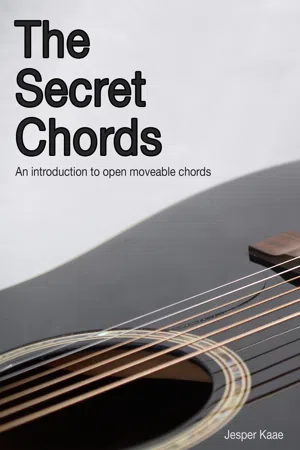
- English
- ePUB (mobile friendly)
- Available on iOS & Android
About this book
Grab a standard open E chord and move it five frets up the neck and you will get a beautiful sounding Aadd9 chord. Open moveable chords are seldom described despite the vast amount of guitar literature available. Although often used by various artists these chords and chord systems are well kept secrets to many aspiring guitarists. This book will help expand your chord vocabulary with a set of new and refreshing chords that will inspire you and spark your creativity. Open moveable chords combine the movability of the barre chords and the easy fingering of the standard open chords, and they create some interesting new sounds at the same time. These types of chords will often add complex harmonic extensions to standard major/minor chords so this book focuses on scale degrees rather than chord names to simplify the theoretically complex nature of open moveable chords. The book also includes options for using pedal points on standard open chords. The Secret Chords contains explanatory introductions to each chapter but it is primarily a comprehensive collection of chord charts for open moveable chords. Read less and play more.
Frequently asked questions
- Essential is ideal for learners and professionals who enjoy exploring a wide range of subjects. Access the Essential Library with 800,000+ trusted titles and best-sellers across business, personal growth, and the humanities. Includes unlimited reading time and Standard Read Aloud voice.
- Complete: Perfect for advanced learners and researchers needing full, unrestricted access. Unlock 1.4M+ books across hundreds of subjects, including academic and specialized titles. The Complete Plan also includes advanced features like Premium Read Aloud and Research Assistant.
Please note we cannot support devices running on iOS 13 and Android 7 or earlier. Learn more about using the app.
Information
En
Combining Open Moveable Chords
Part Otte
Combining Open Moveable Chords
E Major Scales Combined Chords 1


E Major Scales Combined Chords 2


Part Ni
Pedal Points
Table of contents
- Copyright
- I. The Secret Chords
- II. Open Moveable Major Chords
- III. Open Moveable Minor Chords
- IV. Harmonized Major Scales
- V. Harmonized Major Scales – Other Shapes
- VI. Harmonized Minor Scales
- VII. Other Moveable Chords
- 1. Combining Open Moveable Chords
- VIII. Combining Open Moveable Chords
- IX. Pedal Points
- Also by Jesper Kaae: